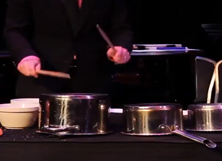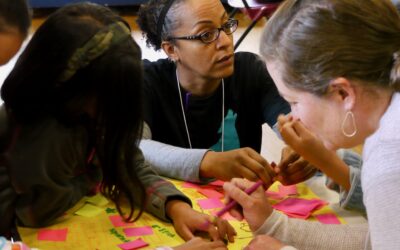This curriculum guide provides an outline of a unit on sound energy for grade 1. During the initial elicitation of students’ ideas, many ideas and topics may be brought up by students. Use these examples as avenues for investigations and developing understanding. Modifications to this outline are essential to being responsive to your students’ learning.
Central to this unit are the ideas that students offer in their attempts to explain the anchoring phenomenon. By honoring multiple types of talk and eliciting student ideas, the teacher can identify touchpoints of students’ ideas and examples that become the focus for later investigations and activities. The explanation of the anchoring event can also be turned toward identifying problems with sound that students and their communities experience. This opens avenues to engineering solutions that address relevant issues that may be related to critical and political elements.
Students investigate the phenomenon of creating kitchen drums with pots and pans. A musician uses kitchen implements, including pots and pans, to play a song in a concert hall. How do they make loud sounds? Soft sounds? High sounds? Low sounds? How does the material or where the object is matter in the kind of sound it can make when we hit it? Students use investigations of force, volume, vibrations, and materials to design, build, and play their recycled instruments.
This unit is structured by alternating investigations and data discussions plus modeling with “create” lessons so students have multiple contexts to explore each science concept and link them together over time. Ultimately, the models students develop can be of other sound-related phenomena to see that the same big science ideas about sound help us explain the kitchen drums that help us understand why we can hear cars outside or why we need to use soft footsteps when walking in the hallway.

 Students investigate the phenomenon of kitchen drums. A musician group uses kitchen implements, including pots and pans, to play a song. How do they make loud sounds? Soft sounds? High sounds? Low sounds? How does the material or what the object touches matter in the kind of sound it can make when we hit it? This unit is structured with alternating science lessons with “create” lessons so students have multiple opportunities to explore each science concept and then link them together over time. Ultimately, the models students develop can be of other sound-related phenomena to see that the same big science ideas about sound help us explain the kitchen drums that help us understand other sound phenomena such as why we can hear cars outside or why we need to use soft footsteps when walking in the hallway.
Students investigate the phenomenon of kitchen drums. A musician group uses kitchen implements, including pots and pans, to play a song. How do they make loud sounds? Soft sounds? High sounds? Low sounds? How does the material or what the object touches matter in the kind of sound it can make when we hit it? This unit is structured with alternating science lessons with “create” lessons so students have multiple opportunities to explore each science concept and then link them together over time. Ultimately, the models students develop can be of other sound-related phenomena to see that the same big science ideas about sound help us explain the kitchen drums that help us understand other sound phenomena such as why we can hear cars outside or why we need to use soft footsteps when walking in the hallway.





 This site is primarily funded by the National Science Foundation (NSF) through Award #1907471 and #1315995
This site is primarily funded by the National Science Foundation (NSF) through Award #1907471 and #1315995